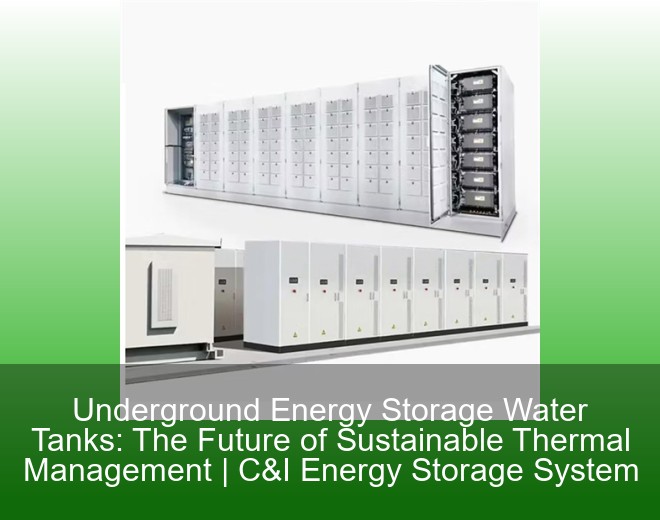
Imagine storing excess wind energy in underground salt caverns like squirrels hoarding acorns for winter. That's essentially what compressed air energy storage (CAES) does – but for the power grid. As renewable energy adoption skyrockets, this 1970s-era technology is getting a 21st-century makeover, with global investments projected to reach $12.7 billion by 2030[10]. [2024-10-16 03:13]

While most of us were grooving to disco music in 1978, Germany quietly launched an energy revolution in Huntorf. This unassuming town became home to the world's first compressed air energy storage (CAES) plant - essentially a gigantic underground battery that's still humming along today. Talk about German engineering! [2024-07-09 23:58]

a "power bank" so massive it could charge 6 million Tesla Model 3s simultaneously. That's essentially what China has been building in its quest to dominate renewable energy storage. As the world's biggest carbon emitter races toward carbon neutrality, its largest energy storage project in China isn't just breaking records - it's rewriting the rules of how nations handle renewable energy. [2022-09-21 23:10]

If you’re here, you’re probably asking: “What’s the big deal about air storage chambers?” Whether you’re an engineer, a sustainability enthusiast, or just someone who Googled “weird giant air batteries,” this article’s got you covered. Let’s break down why this matters—and why you should care. Spoiler: It’s not just about storing air. [2020-05-26 11:30]

An island nation using compressed air to store enough energy to power 200,000 homes. That’s exactly what Madagascar’s groundbreaking 200MW Compressed Air Energy Storage (CAES) project aims to achieve. But why should you care? Well, if you’ve ever cursed at a flickering lightbulb during a blackout or wondered how remote areas can harness renewable energy, this is your backstage pass to the future of power. [2019-12-12 04:01]

If you’re a policymaker in Nicosia googling "renewable energy storage solutions" at 2 AM (we’ve all been there), or a tech-savvy engineer curious about compressed air energy storage (CAES), this article is your caffeine fix. Let’s face it – Cyprus isn’t exactly swimming in fossil fuels, but it’s got sunshine and wind to spare. The catch? Storing that energy when the grid says “no more tacos, please.” [2019-10-24 12:20]

Let's play a quick game. What do natural gas peaker plants, salt caverns, and your bicycle pump have in common? Give up? They're all key players in traditional compressed air energy storage (CAES) - the OG solution for storing excess electricity that's suddenly become cool again. While lithium-ion batteries hog the spotlight, this veteran technology has been quietly powering grids since 1978. Who said energy storage can't have retro charm? [2019-09-28 05:57]

engineers scratching their heads over energy bills, urban planners sweating (literally) about carbon footprints, and eco-warriors dreaming of net-zero cities. If you’re in any of these camps, welcome! Underground energy storage water tanks are like the Swiss Army knives of thermal management—solving multiple problems while hiding beneath our feet. These systems store excess heat or cold in water reservoirs underground, ready to be tapped when needed. Think of them as giant thermal piggy banks for buildings, factories, or even entire neighborhoods. [2025-07-26 09:20]

Let's start with a wake-up call: That 100 gigawatt-hours of electricity generated annually by energy storage systems? That's enough to brew 7.2 billion pots of coffee – enough caffeine to keep New York City wired for 18 months straight[1]! The $33 billion global energy storage industry isn't just about keeping the lights on anymore; it's rewriting the rules of how we power everything from smartphones to smart cities. [2025-07-05 12:07]

Let’s face it – when most people hear “energy storage,” they picture giant batteries or maybe sci-fi energy cubes. In a narrow sense, energy storage refers specifically to storing electricity, like saving sunshine captured by solar panels for your midnight Netflix binge. But here’s the kicker: this technology is reshaping our energy landscape faster than avocado toast took over brunch menus. From Tesla’s massive Megapacks in California to China’s 130+ newly approved storage projects[2][9], the global energy storage market is projected to hit $490 billion by 2030. Not bad for something that essentially acts as a planetary-sized charging cable! [2025-02-25 16:49]

Imagine if your smartphone battery could recharge itself using gravity. Sounds wild, right? That’s essentially what hybrid energy storage systems—especially those combining pumped hydro with newer tech—are doing for power grids. As renewable energy booms, grids need smarter ways to store excess solar and wind power. Enter hybrid systems: the ultimate multitaskers in the energy world. Let’s unpack why they’re stealing the spotlight. [2025-02-02 06:47]

the sun isn’t shining, wind turbines stand still, and your coffee maker demands electricity. Non-battery energy storage projects quietly become the unsung heroes of our power grids. This article isn’t just for engineers—it’s for business leaders, eco-warriors, and anyone curious about how we’ll keep Netflix running during a blackout. [2024-12-31 23:13]
Enter your inquiry details, We will reply you in 24 hours.
Brand promise worry-free after-sales service